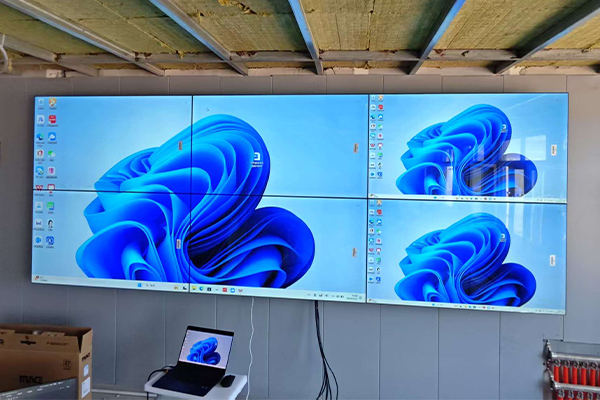Analysis of the core elements of LCD splicing screen: size, seams, installation and maintenance
Beloong LCD splicing screen, as the core carrier of modern large-screen display technology, has been widely used in security monitoring, command and dispatch, commercial display and high-end conference fields. Beloong LCD splicing screen's free splicing, high-definition picture quality and stable performance are reshaping the way visual information is presented. To give full play to its effectiveness, it is necessary to accurately grasp the four major technical elements: size, seam, installation and maintenance.
1. Beloong LCD splicing screen size selection: adapt to scene requirements
The size selection of LCD splicing screen needs to take into account the space scale and viewing distance. The current mainstream sizes in the market are 46 inches, 49 inches and 55 inches, among which 55 inches has become the mainstream choice for its high cost performance and shocking vision. The size of a single 55-inch screen is about 1213.5mm×684.3mm, while the size of a 46-inch screen is 1021.98mm×576.57mm14. Beloong LCD splicing screen can flexibly construct display walls of several square meters to tens of square meters through M×N matrix splicing (such as 2×2, 3×3, 4×4, etc.), meeting the differentiated needs from small conference rooms to large command centers.
2. Beloong LCD splicing screen splicing parameters: balancing effect and cost
The splicing seam is the physical gap between the screen borders, which directly determines the intensity of the picture splitting. The mainstream specifications include economical 3.5mm, advanced 1.7mm/1.8mm, and flagship 0.88mm ultra-narrow splicing seam14. Selection suggestions:
3.5mm splicing seam: moderate price, suitable for limited budget or medium and long distance viewing scenes (such as shopping mall information screen)
≤1.8mm splicing seam: significantly improves the integrity of the picture, suitable for close viewing in high-end conference rooms and exhibition halls
0.88mm splicing seam: nearly seamless visual experience, designed for scenes with strict requirements on picture continuity (such as command center)
Beloong LCD splicing screen The price may increase by 20%-30% for every 1mm reduction in splicing seam, and a comprehensive decision needs to be made based on budget and display accuracy.
3. Beloong LCD splicing screen installation method: harmony of space and function
The Beloong LCD splicing screen installation plan needs to be customized according to the space structure, screen size and maintenance requirements. The mainstream methods include:
Wall-mounted bracket: small-scale splicing (≤3×3), solid load-bearing wall/wall installation, minimum thickness/low space requirement, need to remove the edge
Vertical bracket: large-scale splicing, good ground load-bearing/need to reserve ≥650mm rear space/high space requirement, rear channel maintenance
Floor-standing cabinet: high-end exhibition hall, conference room, overall beauty, cabinet depth ≥650mm/medium space requirement, rear door space required
Embedded: wall renovation project/wall slotting, 5-10cm over the screen on all sides/low space requirement, need to remove the edge
Front maintenance: space is limited and no rear channel can be left/screen pops up in front, no rear space required/extremely high space requirement, front operation
Note: Front maintenance breaks through traditional limitations, Beloong LCD splicing The screen moves forward through a paddle or bead pressing structure, which is particularly suitable for conference rooms installed against the wall.
4. Beloong LCD splicing screen maintenance strategy: ensure long-term operation
Maintenance methods and installation solutions are deeply coupled:
Rear maintenance: A 70cm-1m wide channel needs to be reserved behind the screen, which is suitable for vertical bracket/cabinet installation. During maintenance, technicians inspect from the back
Front maintenance: The screen can pop forward 20-30cm, and the module or line can be replaced directly at the front to solve the pain point that the wall installation cannot be repaired
The daily maintenance of Beloong LCD splicing screen should pay attention to three points:
Regular cleaning: Wipe with lint-free soft cloth + special cleaning agent, and alcohol/ammonia solution is prohibited
Heat dissipation guarantee: Ensure that the back of the Beloong LCD splicing screen has a ventilation space of ≥20cm to avoid color decay caused by high temperature
Signal and color calibration: Check the cable connection every month, unify the color parameters through professional software every quarter, and prevent multi-screen color difference
The deployment of the Beloong LCD splicing screen system is a fusion practice of spatial mechanics, electronic engineering and visual aesthetics. From the matrix combination of 55-inch units to the visual disappearance of 0.88mm seams, from the majestic grandeur of the cabinet-style floor-standing to the flexible adaptability of the front-maintenance type, the essence of Beloong LCD splicing screen professional display solutions is to find the best balance within the constraints. When each parameter is precisely matched with the scene requirements, an infinite vision can be released in a small space.

